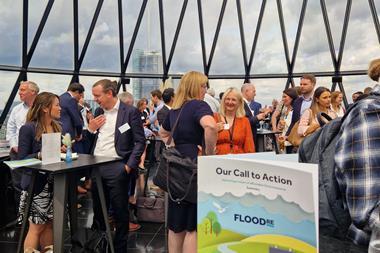UK and Ireland general insurance chief executive says practical solutions are needed
The government needs to work “hand in glove” with the insurance industry to ensure homes are built in the right places amid climate challenges.

That was according to Aviva’s UK and Ireland general insurance chief executive Adam Winslow, who said that “our homes are at risk like never before”.
Winslow yesterday attended a roundtable discussion in Parliament on the need for planning and building regulations to adapt to the severe impacts of more extreme weather, where he emphasised the need for greater collaboration on planning.
In a LinkedIn post earlier this week (4 July 2023), he explained: “The climate crisis is bringing more extreme heat, subsidence, storms and floods and we know there is more in store.
“One in every four homes in the UK is at risk of flooding and at Aviva all too often we see the impact this has.”
According to Winslow, the average cost of restoring homes for affected customers had been £60,000 per household over the last six years.
“Of course, the emotional cost and disruption to people’s lives goes far beyond that,” he added.
“The country urgently needs to adapt to the reality of a warmer planet and Aviva’s Climate-Ready Index, launched last year, found that 86% of consumers agreed that our buildings and infrastructure need to be at the heart of those changes.”
‘Practical solutions’
Winslow also highlighted that the planning system and building regulations needed to adapt quickly to the impacts of more extreme weather amid an “overwhelming demand for new houses” – the government has set a target of delivering 300,000 new homes per year by the mid-2020s.
Read: Brokers lack urgency and interest in net zero transition – Ecclesiastical Insurance
Read: RSA Insurance partners with charity to help reduce flood risk
Explore more sustainability content here or discover other news stories here
Winslow admitted that the challenge “would not be easy”, but stressed that a solution needed to be found so that homes were not being built in the wrong places.
“National and local government need to work hand in glove with the construction and insurance industries to find practical solutions to ensure we build the right homes in the right places – not just for today, but long into the future too,” he said.
Winslow added that the current reforms to the planning system ”give us all a golden opportunity to get our communities more climate ready”.
These reforms aim to improve the planning system and further empower local leaders to regenerate their local area.
Winslow said it should be aligned with, and support, the nation’s net zero targets.
Speaking about what else the reforms should achieve, he added: “Firstly, that the reforms go further to prevent development of homes and commercial buildings in current and future flood zones.

“Secondly, that where development in flood risk areas is unavoidable, planning requires that buildings have appropriate flood resistance, mitigation and resilience measures built in – and that there is extra capacity to enforce these planning conditions.”
Resilience measures
Earlier this year (22 May 2023), Flood Re launched a new campaign to help householders better protect themselves against the impact of future flooding by adapting their homes with property flood resilience (PFR) measures.
These aim to reduce the risk and cost of damage to homes, as well as speed up recovery and restoration time, in the event of a flood.
But Winslow stressted that at least in high-risk areas, property-level resilience measures should be part of the design and construction phase of any building rather than owners or leaseholders having to retrofit them later on.
“There should be effective oversight to make sure these are included before the building is handed over, rather than expecting the owners or leaseholders to retrofit them at significant personal cost later on,” he added.












































No comments yet